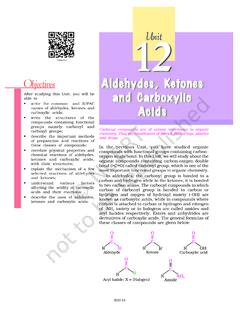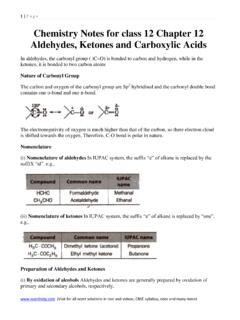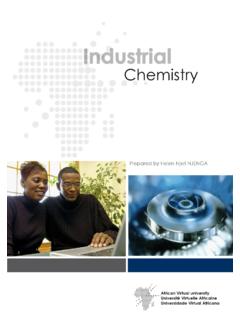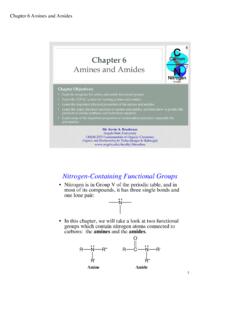Transcription of Synthesis of Aspirin - Columbia University
1 Synthesis of AspirinSynthesisSynthesisPurificationPur ificationCharacterizationCharacterizatio nAspirin: some background!!Patented by Bayer in 1893 Patented by Bayer in 1893!!One of the oldest drugsOne of the oldest drugs!!One of the most consumed drugs One of the most consumed drugs (Production in the US is 10 million (Production in the US is 10 million Kg/year)Kg/year) Aspirin : Biological activity!!Analgesic (painkiller)Analgesic (painkiller)!!Antipyretic (fever reducer)Antipyretic (fever reducer)!!AntiAnti--inflammatory (inhibition of the Synthesis of inflammatory (inhibition of the Synthesis of prostaglandinsprostaglandins))!
2 !Side effects: gastric irritation, bleedingSide effects: gastric irritation, bleedingApparition of new analgesics (Tylenol)Apparition of new analgesics (Tylenol) Aspirin : The MoleculeOOHHOOO acetyl salicylic acid ( Aspirin )Organic backgroundAlcohols!!AlcoholsAlcohols!!Al iphatic alcoholsAliphatic alcohols: Hydroxyl derivatives of saturated hydrocarbons: Hydroxyl derivatives of saturated hydrocarbons!!EnolsEnols: Hydroxyl derivatives of unsaturated hydrocarbons: Hydroxyl derivatives of unsaturated hydrocarbonsROHH3 COHmethanolOHethanolOHRR enolOHphenolOrganic backgroundCarboxylic acidacetic acidbenzoic acidROOHO rganic backgroundEsterificationR1 OHOHOR2R1 OOR2carboxylic acidalcoolesterH++This is an equilibrium!
3 Organic backgroundEsterification mechanismR1 OHOHOR2R1 OOR2carboxylic acidalcoolesterR1 OHOHOH+R2H+R1 OHOH2+OR2-H+Organic backgroundAcidity: a review!!BronstedBronsted--Lowry acidLowry acidSubstance that can donate a protonSubstance that can donate a proton!!Lewis acidLewis acidSubstance that accepts loneSubstance that accepts lone--pair electronspair electrons!!AH + HAH + H22O O ""AA--+ H+ H33OO++KKaa= [= [HH33OO++][A][A--] / [] / [AH]AH]pKpKaa= = --Log KLog Kaa11 Sulfuric acidSulfuric acidFormic acidBenzoic acidAcetic acidOOOacetic anhydrideOOHHOOO acetyl salicylic acid ( Aspirin )OHOacetic acidH2SO4heat++Reaction mechanismOHHOOOOOOHOOOOHOH+OHOOH+OHOO+-H +Safety!
4 !Consult MSDS for safety information on all the chemicals Consult MSDS for safety information on all the chemicals you plan to plan to use.!!MSDS are available from the 2507 MSDS are available from the 2507 procedure!!Mix salicylic acid (solid) with acetic anhydride (liquid) and a Mix salicylic acid (solid) with acetic anhydride (liquid) and a catalytic catalytic amount of Hamount of !!Heat for 10 min at 90 Heat for 10 min at !!Cool down to room temperature and add water (crystallization Cool down to room temperature and add water (crystallization solvent).)
5 Solvent).!!Induce crystallization.!!Filter the the by RecrystallizationWHAT IS WHAT IS RECRYSTALLIZATION?RECRYSTALLIZATION?##Ra pid and convenient way of Rapid and convenient way of purifying a solid organic purifying a solid organic compoundcompound##The material to be purified is The material to be purified is dissolved in the hot appropriate dissolved in the hot appropriate solventsolvent##As the solvent cools, the As the solvent cools, the solution become saturated with solution become saturated with respect to the substance, which respect to the substance.
6 Which then crystallizethen crystallize##Impurities stay in solutionImpurities stay in solutionMETHODMETHOD##Choose the solvent Choose the solvent ##Dissolve the soluteDissolve the solute##(Filter suspended solids)(Filter suspended solids)##Crystallize the soluteCrystallize the solute##Collect and wash the Collect and wash the crystalscrystals##Dry the crystalsDry the crystalsAssessment of purity: Looking for propertiesPhysical propertiesPhysical properties!!Physical appearancePhysical appearance!!SolubilitySolubility!
7 !Melting pointMelting point!!Infrared spectraInfrared spectraChemical propertiesChemical properties!!Percent yieldPercent yield!!Potentiometric Potentiometric titrationtitration!!Phenol testPhenol testAssessment of purity: Physical appearance!!Physical state (solid? liquid? ..)Physical state (solid? liquid? ..)!!ColorColor!!OdorOdor!!TextureTextur e!!Homogeneity in compositionHomogeneity in compositionAssessment of purity: Solubility!!In a test tube, transfer a small amount of your In a test tube, transfer a small amount of your product (end of a spatula)product (end of a spatula)!
8 !Add ~1/2mL of solventAdd ~1/2mL of solvent!!Determine solubility at room temperatureDetermine solubility at room temperature!!If not, gently heat and determine solubility at If not, gently heat and determine solubility at higher temperaturehigher temperature!!Test several organic solvents and compare with Test several organic solvents and compare with litterature litterature Assessment of purity: Melting point!!Melting point characterize the compoundMelting point characterize the compound!!Range of the melting point indicate the purity of Range of the melting point indicate the purity of the compoundthe compound!
9 !MethodMethod: scanning of the temperature until melting : scanning of the temperature until melting occurs. Determine start and end temperature of occurs. Determine start and end temperature of melting. melting. !!Don t heat too fast!! (<1 Don t heat too fast!! (<100C / min) C / min) Assessment of purity: Infrared Spectra!!Dissolve the product in chloroform and obtain the Dissolve the product in chloroform and obtain the IR spectrum.!!Assign the peaksAssign the peaks!!Do you see impurities?Do you see impurities?
10 !!Compare with the reference with the reference of purity: Percent yield!!Definition: %Yield = Definition: %Yield = nnexpexp/n/nthth!!Write down the reaction with the correct Write down the reaction with the correct stoechiometrystoechiometry. Ex: A+B . Ex: A+B ""CC!!Prepare a chart like below and calculate a chart like below and calculate (mol)(mol)experimentalexperimentalmmcc(g )(g)experimentalexperimentalnnC C (mol)(mol)theoreticaltheoreticalmmCC(g)( g)theoreticaltheoreticalnnBB(mol)(mol)mm BB(g) (g) or Vor VB B ((mLmL))nnAA(mol)(mol)mmA A (g) (g) or Vor VA A ((mLmL))Assessment of purity: potentiometric titration!
















